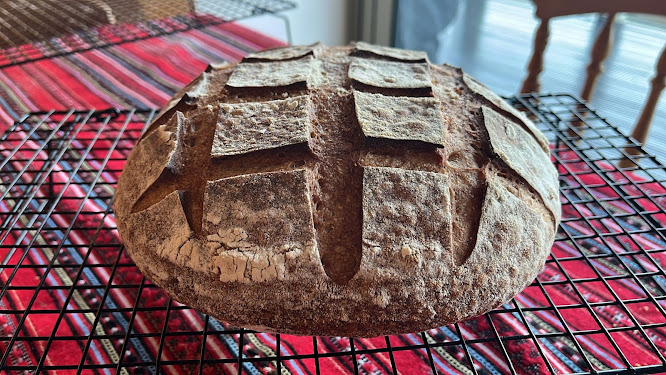Firehouse White Sourdough - a BC20 Trial (Medium Difficulty)
Welcome to another step-by-step recipe from BreadClub20. Why not drop by our main Facebook page by clicking here.... If you like what you see and enjoy the recipe, we hope you join us by 'Liking' and 'Subscribing'
The other day, I was reminded of the Sourdough technique employed by Patrick Ryan, the owner of Firehouse Bakery in Wicklow in the Republic of Ireland.
His white sourdough technique is a little different from what most people see as the 'basic' way to miss, develop and bake sourdough.
So, I thought, let's give it a trial and see how it goes.
We're going to bake it two ways
1. As a same-day bake, i.e. mix, knead, prove, shape, prove and bake all in one day, and
2. As an overnight prove, i.e. mix, knead, prove, shape, prove overnight and bake the next day/
Look out for the descriptions with the photos to see the progress with each bake.
FORMULA
400 gms of strong white flour
5 gms crushed sea salt
230 gms tepid water
160 gms active sourdough starter
PROCESS
1. Add the flour to the bowl and then mix in the salt.
2. Add the starter and the water and bring everything together,
3. Mix and then knead until you have a soft and springy dough. The mix will seem wet for a while and rather sticky. Persevere and do not add any extra flour. Eventually, it will come together into a dough. Expect to knead for at least ten minutes.
I've also made this using an instant start programme on a bread machine (i.e. pizza) and watched the dough knead with the lid open, stopping it when the dough is thoroughly kneaded and is soft and silky
4. Place the dough in a lightly oiled bowl, cover and leave at room temperature for about 4 hours.
The one below was left at 23⁰C for fifteen minutes short of the four-hour mark.
5. Turn the dough out onto a clean work surface.
A very fine coating of rice flour, semolina or a misting of water may well help to stop the dough sticking.
6. Knock the air out of the dough which equalises the temperature throughout the whole dough.
7. Form the dough into a tight boule
8. Prepare a proving banneton that is large enough to accommodate the dough when it has proved for a second time.
9. Place the dough into the banneton loosely cover and leave at the same temperature as earlier for about three to three and a half hours.
Alternatively, instead of proving it at room temperature, you can place the bannton into a plastic bag and put it into the refrigerator for 12 - 20 hours.
The one above was taken just before it was placed in the refrigerator for 20 hours at 3⁰C
The one below was photographed after being second-proved for 3.5 hours and prior to being baked on the same day...
11. Place a tray of water into the oven while it's preheating
12. Carefully invert the dough onto a piece of parchment paper and then, when the oven is ready and the water is boiling, score the dough and place it onto the preheated sheet/stone.
13. Bake for 30 - 35 minutes or until a good colour has been formed and the loaf is hollow when tapped underneath.
Happy baking
SAME DAY MAKE AND BAKE
VERDICT?
1. The rise was disappointing. If I were to repeat this exercise, I'd be baking in a container - Dutch oven or similar - to support the bread during the early stages and not allow spread (which was minimal_ but also to encourage upward growth. I'd also consider adding a little diastatic malt to boost the yeast and bacteria.
2. Having a blanket 'three-hour proof' in a banneton leaves too much to chance. This is the problem of proving without being able to judge the increase in volume with any degree of accuracy.
Generally.....disappointment. It's Okay, but not one I'd rush after again.
OVERNIGHT PROVE AND BAKE
Firehouse cookery school
Firehouse Bakery
 |

















Comments
Post a Comment